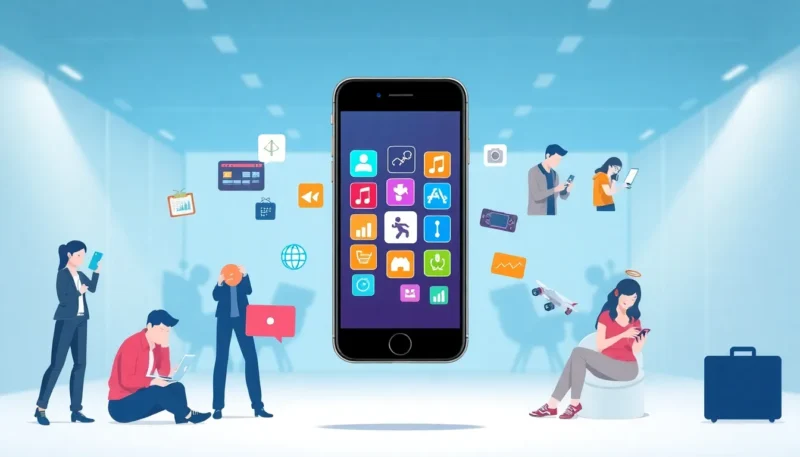
Wondering how safe your bank’s app really is? You’re not alone. The convenience of banking from your pocket comes with a hefty dose of concern about security. After all, who wouldn’t fear becoming a headline for hacker exploits? Let’s jump into the world of mobile banking apps, where safety and security should be a priority, not just a marketing tagline. Buckle up as we explore features, risks, and best practices: it’s about to get enlightening.
How Safe Are Mobile Banking Apps

Mobile banking security refers to the measures and protocols put in place to protect users’ financial data and privacy while using banking apps on their smartphones or tablets. It’s essential to understand that these apps often serve as the direct line between a consumer’s finances and potential digital threats. Also, with the increasing popularity of mobile banking, understanding security fundamentals has never been more critical.
Two main components define mobile banking security: user authentication and data encryption. User authentication ensures that only legitimate app users can access their accounts. This process often includes features like multi-factor authentication, which requires users to confirm their identity through multiple methods. Consider a typical scenario where the app requires a password and a text message code, this makes unauthorized access incredibly difficult.
On the other hand, data encryption securely transforms sensitive information into a coded language. This means even if a hacker intercepts data, they can’t decode it without the encryption key. Think of it as sending a postcard versus a locked, sealed envelope: the envelope keeps prying eyes away.
As consumers familiarize themselves with mobile banking, it’s crucial to stay informed about these security aspects. This knowledge not only enhances confidence but also empowers users to make wise choices about app usage.
Common Security Features in Mobile Banking Apps
Most modern mobile banking apps integrate several security features designed to protect users. Here’s a discussion of some common yet effective ones:
Biometric Authentication
Biometric authentication, including fingerprint and facial recognition, has taken mobile banking security to a new level. It’s fast, provides convenience, and significantly enhances safety. Users simply need to place a finger on the sensor or glance at their phone, eliminating the need to remember lengthy passwords.
Encryption Technology
As mentioned earlier, encryption protects sensitive data during transmission. Look for apps that use advanced encryption standards like AES encryption, considered one of the safest methods available. This ensures even if data is intercepted, it remains unreadable.
Transaction Alerts
Heard of alert notifications? These enable users to receive real-time updates about any account activity. If a transaction appears that wasn’t initiated by the user, they can quickly act to secure their account. Setting these alerts is like having a watchdog for your finances, always barking whenever something suspicious happens.
Two-Factor Authentication (2FA)
2FA adds another layer of security beyond passwords. Users must verify their identity through a second method, such as receiving a code via text message. This layer is akin to a double lock: it keeps the bad guys out and your money safe.
Understanding these features can give consumers a significant advantage in knowing how to choose safer banking applications. The options are numerous, but evaluating security functionalities is paramount.
Potential Risks and Threats
Even though the imperative security features, mobile banking isn’t entirely risk-free. Users must remain vigilant against a variety of threats that target mobile banking environments:
Phishing Attacks
Phishing attacks remain one of the primary threats to mobile banking users. These occur when cybercriminals mimic legitimate messages or websites to lure users into revealing personal information. A user might receive a text claiming to be from their bank, asking them to verify their account through a link. Clicking that link can compromise security and lead to data theft.
Malware
Mobile malware is another menacing threat. Malicious software often disguises itself as legitimate apps, allowing it to siphon sensitive data from users. Once installed, these apps can operate undetected, monitoring activities as well as stealing passwords and other personal information. Regularly updating software can help mitigate this risk, as these updates typically include security patches.
Public Wi-Fi Vulnerabilities
Connecting to banking apps via public Wi-Fi can make users vulnerable to hackers. This temptation is high in cafes or airports, yet it’s risky. Using an unsecured network can make transactions susceptible to interception by malicious actors. Consider your surroundings: opting for mobile data instead offers additional security.
Raising awareness about these risks empowers users to take the necessary steps to protect themselves. Being informed isn’t just an advantage: it’s essential.
Best Practices for Safe Mobile Banking
Whether a banking app enthusiast or a cautious user, implementing best practices can significantly enhance mobile banking security. Here are crucial strategies:
Use Strong Passwords
A secure password is a fundamental barrier against unauthorized access. Users should create complex passwords that are hard to guess. Avoid simple combinations like “123456”, you’re not trying to invite trouble.
Enable Security Features
Take advantage of built-in security features. Enabling two-factor authentication and biometric authentication provides that much-needed extra layer of security.
Regular Updates
Ensure the banking app is updated regularly. App developers often release updates to patch security vulnerabilities and provide the latest features. Ignoring updates is like ignoring a leaky roof – it’s only going to get worse over time.
Monitor Accounts
Regularly reviewing account statements and transactions is crucial. Early detection of unauthorized transactions can save both time and money. If something doesn’t feel right, act quickly.
Adhering to these best practices can immensely reduce vulnerabilities. Mobile banking shouldn’t feel like walking a tightrope: with effective measures, it can be a walk in the park.
Comparative Analysis of Leading Banking Apps
Not all mobile banking apps are created equal. A comparative analysis of a few leading apps can offer insight into who leads the way in security:
Chase Mobile App
Chase’s app offers for its users cutting-edge security features, including biometric login and real-time transaction alerts. The positive user feedback on security features reinforces that it’s a trustworthy option for mobile banking.
Bank of America
This app stands out thanks to its Zelle integration and robust encryption practices. Users love the convenience paired with advanced security protocols. It has seen consistently high ratings from both critics and users about security.
Wells Fargo
While Wells Fargo’s app offers a full slate of features, several users have raised security concerns. It advocates for user awareness about online threats, but the app could improve in certain security measures based on feedback.
Capital One
With a strong focus on user security, Capital One provides alerts for suspicious activities and allows clients to easily lock and unlock their cards from the app. This proactive stance positions them highly on the security scale.
Summarizing, reviewing app features and security options is paramount when deciding which banking app to use. The banking landscape is competitive, but security should guide the user’s choice.
The Future of Mobile Banking Security
The future of mobile banking security looks promising, with innovative technologies emerging rapidly. Here’s what to expect:
Artificial Intelligence
The integration of artificial intelligence could revolutionize mobile banking security. Algorithms can analyze transaction patterns and detect flagged inconsistencies much faster than human oversight. This technology adapts in real-time, potentially neutralizing threats before they escalate.
Blockchain Technology
Considered a game-changer, blockchain offers unparalleled security through decentralized data management. As this technology becomes mainstream in financial services, its potential to safeguard transactions will likely reshape banking.
Enhanced User Education
Financial institutions are increasingly focused on educating their users about security precautions. Training users to recognize phishing tactics or malware risks encourages informed decisions, eventually fortifying the overarching security landscape.
These anticipations paint a vibrant picture of what’s on the horizon for mobile banking security. Adapting to future advancements will be crucial to maintaining safety in an ever-evolving digital world.












